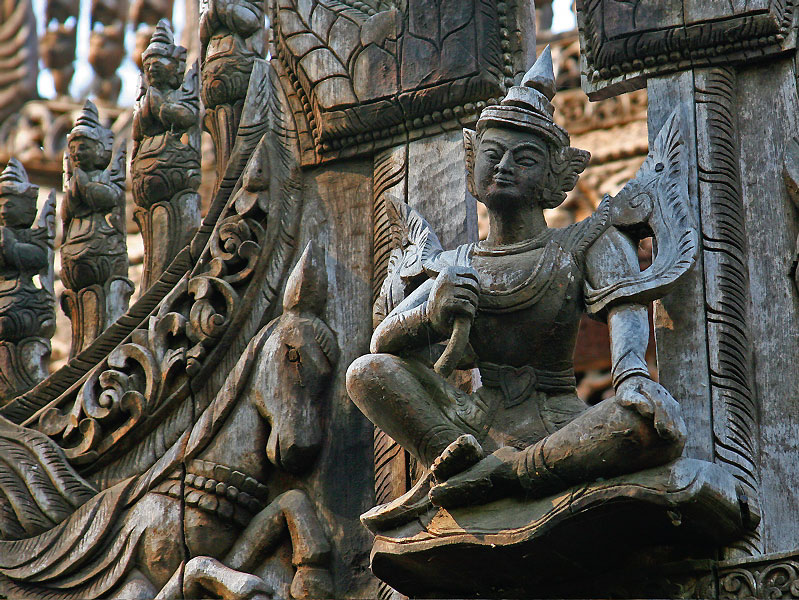Shwenandaw Monastery on:
[Wikipedia]
[Google]
[Amazon]
 Shwenandaw Monastery (, ; lit. "Golden Palace Monastery") is a historic
Shwenandaw Monastery (, ; lit. "Golden Palace Monastery") is a historic
File:Shwe Kyaung Inside.jpg
File:Shwe Kyaung Woodcarving.jpg
File:Shwe Kyaung Corridor.jpg
File:Shwe Kyaung Wooden Ploes.jpg
File:Shwe Kyaung.jpg
File:Mandalay-Shwe-Kyaung.JPG
File:Shvenendav Monastery, gate.jpg
File:Altar in Shwenandaw Monastery Mandalay.jpg
 Shwenandaw Monastery (, ; lit. "Golden Palace Monastery") is a historic
Shwenandaw Monastery (, ; lit. "Golden Palace Monastery") is a historic Buddhist monastery
A monastery is a building or complex of buildings comprising the domestic quarters and workplaces of monastics, monks or nuns, whether living in communities or alone (hermits). A monastery generally includes a place reserved for prayer which may ...
located near Mandalay Hill
Mandalay Hill ( ) is a hill located to the northeast of the city centre of Mandalay in Myanmar. The city took its name from the hill. Mandalay Hill is known for its abundance of pagodas and monasteries, and has been a major pilgrimage site for ...
, Mandalay Region
Mandalay Region (, ; formerly Mandalay Division) is an administrative divisions of Myanmar, administrative division of Myanmar. It is located in the center of the country, bordering Sagaing Region and Magway Region to the west, Shan State to the ...
, Myanmar
Myanmar, officially the Republic of the Union of Myanmar; and also referred to as Burma (the official English name until 1989), is a country in northwest Southeast Asia. It is the largest country by area in Mainland Southeast Asia and has ...
(formerly Burma).
Shwenandaw Monastery was built in 1878 by King Thibaw Min
Thibaw Min, also Thebaw (, ; 1 January 1859 – 16 December 1916), was the last king of the Konbaung dynasty of Burma (Myanmar) and also the last Burmese monarch in the country's history. His reign ended when the Royal Burmese armed forces ...
, who dismantled and relocated the apartment formerly occupied by his father, King Mindon Min
Mindon Min (, ; 1808 – 1878), born Maung Lwin, was the penultimate king of Burma (Myanmar) from 1853 to 1878. He was one of the most popular and revered kings of Burma because of his role in the Fifth Buddhist Council. Under his half brothe ...
, just before Mindon Min's death, at a cost of 120,000 rupees
Rupee (, ) is the common name for the currencies of
India, Mauritius, Nepal, Pakistan, Seychelles, and Sri Lanka, and of former currencies of Afghanistan, Bahrain, Kuwait, Oman, the United Arab Emirates (as the Gulf rupee), British East Afr ...
. Thibaw removed the building on 10 October 1878, believing it to be haunted by his father's spirit. The building reconstruction was finished in 31 Oct 1878, dedicated in memory of his father, on a plot adjoining Atumashi Monastery
The Atumashi Monastery ( ; formally Mahā Atulaveyan Kyaungdawgyi or ) is a Buddhist monastery located in Mandalay, Myanmar (Burma).
History
It was built in 1857 by King Mindon, two years after the capital was moved to Mandalay. The monaster ...
.It is said that King Thibaw used it for meditation, and the meditation couch he sat on can still be seen.
The building was originally part of the royal palace at Amarapura, before it was moved to Mandalay, where it formed the northern section of the Hmannan (Glass Palace) and part of the king's royal apartments. The building was heavily gilt with gold and adorned with glass mosaic
In Myanmar culture, glass mosaic () is a traditional form of glasswork where pieces of glass are used to embellish decorative art, structures, and furniture. Glass mosaic is typically divided into two subcategories, ''hman gyan si'' () and ''hma ...
work.
The monastery is known for its teak
Teak (''Tectona grandis'') is a tropical hardwood tree species in the family Lamiaceae. It is a large, deciduous tree that occurs in mixed hardwood forests. ''Tectona grandis'' has small, fragrant white flowers arranged in dense clusters (panic ...
carvings of Buddhist myths, which adorn its walls and roofs. The monastery is built in the traditional Burmese architectural style. Shwenandaw Monastery is the single remaining major original structure of the original Royal Palace
This is a list of royal palaces, sorted by continent.
Africa
Americas
Asia
Europe
Oceania
{, class="wikitable" width="95%"
, - bgcolor="white"
!align=center, Residence
!align=center, Photo
!align=center, City
!align=cen ...
today.
Notes
Gallery
References
* *External links
Monasteries in Myanmar Buddhist temples in Mandalay Religious buildings and structures completed in 1880 {{Myanmar-Buddhist-monastery-stub